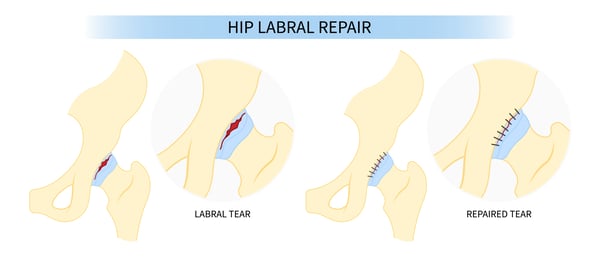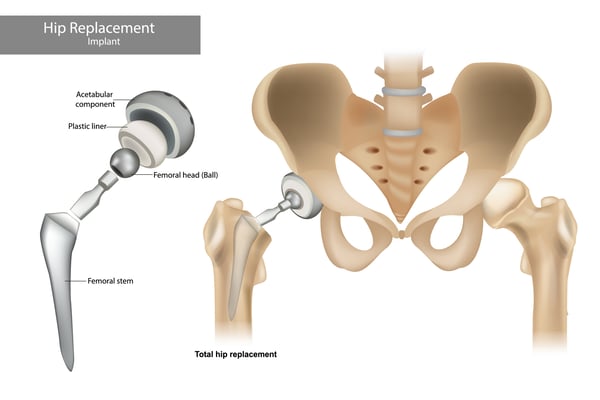Labrum Repair vs. Total Hip Replacement: Procedures, Recovery, and Physical Therapy

Licensed Physical Therapist, PT, DPT // Director of Marketing and Sales // Certified Dry Needling Specialist // EW Motion Therapy Homewood
Navigating the complexities of hip-related surgeries can be challenging, especially when considering options like labrum repair and total hip replacement. These procedures cater to different hip conditions and offer distinct approaches to improving hip function and relieving pain. We love helping our patients at EW Motion Therapy prepare for and recover from surgery with individualized treatment plans and continual collaboration with surgeons. Even if you decide that our services don’t fit your needs, you can still read this comprehensive guide, where we'll delve into the intricacies of these procedures, compare their recovery processes, and explore how physical therapy can be a vital component of both pre and post-surgery.
Labrum repair
Labrum repair focuses on the hip labrum, a ring of cartilage that stabilizes the hip joint. This procedure is typically recommended for patients with labral tears, which can result from injury, structural issues, or repetitive strain. The goal is to repair the torn cartilage, thereby alleviating pain and restoring joint stability.
Depending on the severity, labrum repair can be done arthroscopically or through open surgery. Recovery spans several months, beginning with strict limitations on mobility and weight-bearing activities, followed by a gradual re-introduction of movement and strength exercises. The total recovery time often varies based on the individual's overall health and the extent of the repair.

Total hip replacement: a comprehensive solution
Total hip replacement, or arthroplasty, involves replacing the damaged hip joint with an artificial implant. This surgery is typically considered for severe arthritis or significant joint damage where other treatments have failed. The objective is to provide relief from chronic pain and significantly improve mobility.
Total hip replacement is a more extensive procedure than labrum repair. The recovery process is also more intensive, often requiring an initial hospital stay followed by several months of rehabilitation. The first few weeks post-surgery involve managing pain and preventing complications, after which the focus shifts to regaining mobility and strength. Full recovery can take anywhere from 6 months to a year.

Comparing recovery timelines
Labrum repair patients usually experience a faster recovery compared to total hip replacement. The initial weeks are critical for healing the repaired tissue, requiring limited physical activity. Physical therapy plays a significant role in gradually enhancing joint function and strength.
Recovery from a total hip replacement is more prolonged and involves a more cautious approach to rehabilitation. The emphasis is on ensuring the artificial joint’s proper integration, avoiding dislocation, and regaining strength and mobility.
Physical therapy: a key element in preparation & recovery
Pre-surgical physical therapy (prehab)
Pre-surgical physical therapy for labrum repair focuses on strengthening the hip muscles, improving flexibility, and ensuring the joint is in the best possible condition for surgery. A typical session might include:
- Gentle stretching exercises to improve flexibility around the hip.
- Strengthening exercises targeting the core and hip muscles.
- Low-impact aerobic exercises like stationary biking to maintain cardiovascular health (and range of motion).
- Education on post-surgery expectations and exercises.
Pre-surgical therapy for a total hip replacement also aims to strengthen the surrounding muscles and improve overall joint health. Sessions might involve:
- Exercises to strengthen the thigh and buttock muscles.
- Stretching routines for the lower body to improve flexibility.
- Balance exercises to prepare for post-surgery mobility.
- Biking can be great for cardio and improving range of motion.
- Instruction on using walking aids and adapting to mobility limitations post-surgery.
Post-surgical physical therapy (rehab)
After labrum repair, physical therapy is essential for a successful recovery. A typical post-surgical session might include:
- Initial passive exercises to maintain hip motion without stressing the repaired labrum.
- A gradual introduction of weight-bearing exercises as the healing progresses.
- Advanced strengthening exercises to rebuild the muscles around the hip.
- Functional exercises to return to everyday activities and sports-specific training if applicable.
Following a total hip replacement, therapy is more intensive, focusing on adapting to the artificial joint. A standard session could consist of:
- Early exercises to prevent blood clots and improve circulation.
- Activities to improve range of motion and prevent joint stiffness.
- Strengthening exercises focusing on the hip, thigh, and core muscles.
- Gait training to relearn walking with the new joint, including using walking aids.
- Balance and coordination exercises to prevent falls.
Making the right choice for your needs
When choosing between labrum repair and total hip replacement, consider the nature of your hip condition, the expected outcomes, and the different recovery paths. Both procedures have their place in treating hip issues but cater to different types of problems. The information we have discussed is only a starting point for a deeper conversation with your medical care team. Consulting with orthopedic specialists and physical therapists is crucial to making an informed decision that aligns with your health goals and lifestyle.
Labrum repair and total hip replacement offer different solutions to hip problems, each with unique recovery timelines and rehabilitation needs. Physical therapy remains a cornerstone in both, ensuring a successful recovery and a return to an active, pain-free life. Remember, the journey to recovery is not just about the surgery itself but also the dedicated and personalized rehabilitation that follows. We love helping our post-op patients at EW Motion Therapy recover from their procedures efficiently so they can return to their favorite activities. If you’re curious about what else physical therapy can do for you, click the button below to download our answers to 20 frequently asked questions.


